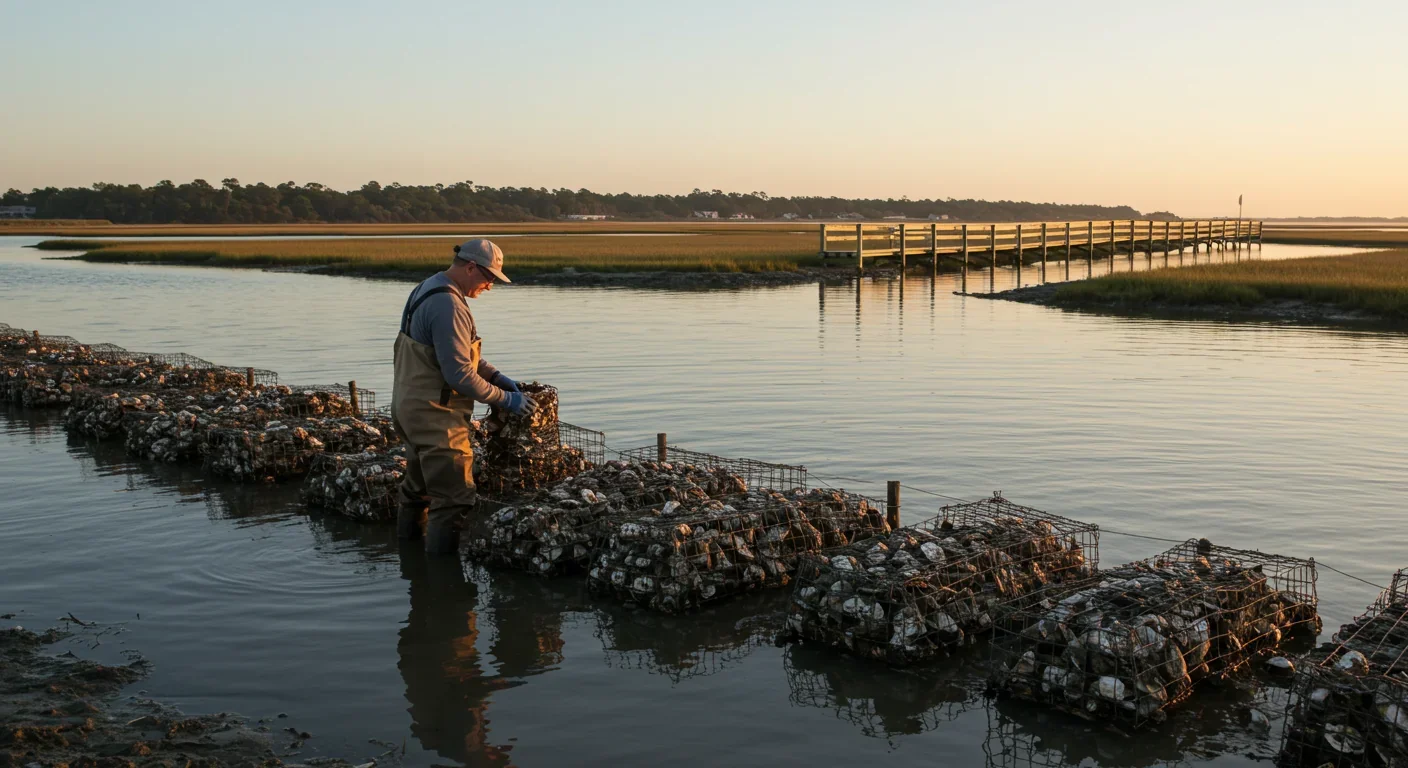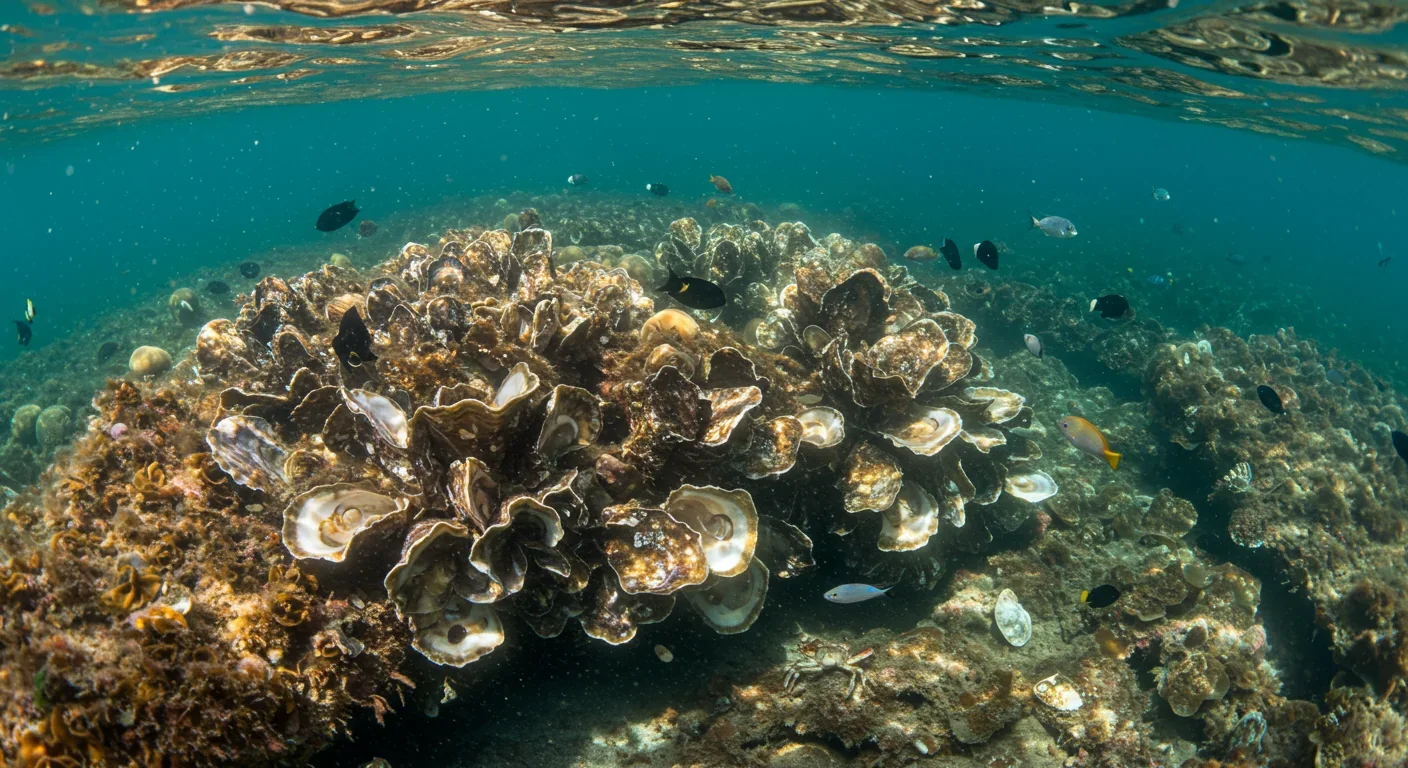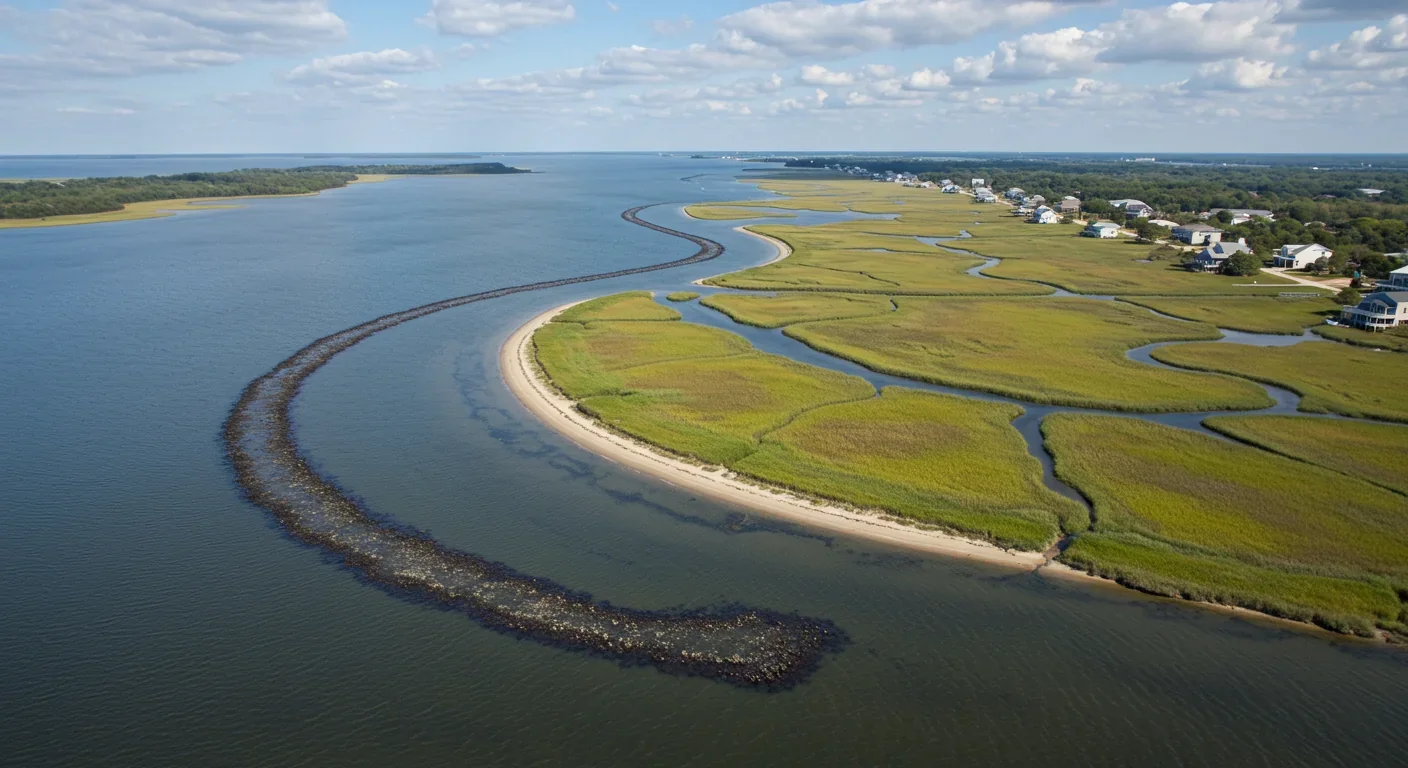Underground Air Storage: Renewable Energy's Hidden Battery

TL;DR: Oyster reef restoration projects are transforming coastal protection by combining wave energy reduction with natural water filtration, delivering measurable improvements in water quality, shoreline stability, and marine habitat at lower costs than traditional seawalls.

By 2030, coastal engineers predict that hundreds of communities worldwide will rely on living oyster reefs instead of concrete seawalls to shield their shorelines. What started as scattered restoration experiments in the Chesapeake Bay and Gulf Coast has become a movement that's rewriting the playbook on coastal resilience. These aren't your typical engineering projects—they're ecosystems that fight back against waves while cleaning billions of gallons of polluted water.
The stakes couldn't be higher. As sea levels rise and storms intensify, traditional hard infrastructure is showing its age. Seawalls crack, levees fail, and the bill for repairs climbs into the billions. Meanwhile, a single oyster quietly filters 50 gallons of water per day, removing nitrogen and phosphorus that fuel toxic algal blooms. Scale that up to reef-sized operations, and you've got a dual-purpose solution that early adopters are calling a game-changer.
The transformation began when scientists realized oyster reefs weren't just nice habitats—they were structural engineers. Living Breakwaters in New York Harbor proved the concept after Hurricane Sandy devastated Staten Island's shoreline in 2012. Designers created reef structures that dissipate wave energy before it reaches shore, cutting erosion rates while simultaneously hosting thousands of oysters that filter the notoriously polluted harbor water.
The engineering is deceptively simple. Oysters naturally cement themselves to hard surfaces, building three-dimensional structures that rise from the seafloor. These rough, complex surfaces break up wave patterns far more effectively than smooth concrete. Research shows that properly designed oyster reefs can reduce wave energy by 30-50%, protecting shorelines while providing habitat for fish, crabs, and other marine species.
But here's what makes this revolutionary: the reefs get stronger over time. Unlike seawalls that deteriorate, healthy oyster populations reproduce and expand, building on the skeletons of previous generations. In Harris Creek, Maryland, restored reefs now filter nitrogen equivalent to 20,000 bags of fertilizer annually—and they didn't exist a decade ago.
Oysters once dominated coastal ecosystems. Historical records describe reefs so massive in Chesapeake Bay that they posed navigation hazards. Watermen reported oyster bars stretching for miles, forming underwater mountain ranges that supported entire fishing economies. Then came industrial-scale harvesting, disease, pollution, and habitat destruction. By the late 20th century, oyster populations had collapsed to roughly 1% of historic levels in many estuaries.
The decline triggered cascading failures. Without oysters filtering water, algal blooms exploded. Dead zones expanded as decomposing algae consumed oxygen. Shorelines eroded faster without reef structures to buffer wave action. The Chesapeake Bay's legendary water clarity—once so transparent you could see bottom in 20 feet of water—turned murky and green.
Early restoration efforts in the 1990s often failed because they didn't understand reef ecology deeply enough. Practitioners dumped oyster shells in random spots, hoping populations would rebound. Most didn't. The turning point came when researchers started thinking like ecosystem engineers instead of simple habitat creators. They realized reefs needed specific depths, water flow patterns, and substrate composition. The 2014 Chesapeake Bay Watershed Agreement set science-based targets for 10 tributary systems, combining federal funding with state resources and nonprofit expertise.
That collaborative model worked. The Chesapeake Bay Program has met and exceeded its restoration goals, demonstrating that large-scale reef recovery is achievable when multiple stakeholders coordinate efforts. The shift from isolated projects to watershed-wide strategies made the difference.
Modern oyster reef restoration combines ecology and engineering in ways that would've seemed radical 20 years ago. The process starts with substrate selection—what material will oysters actually settle on? Recycled oyster shells work best because they provide the calcium carbonate chemistry oysters recognize. Concrete alternatives made from coal ash or crushed limestone can substitute where shells are scarce, though oysters prefer the real thing.
Placement matters enormously. Reefs positioned too deep get smothered by sediment; too shallow and they dry out during low tides. The sweet spot varies by location, but generally reefs thrive in the intertidal and shallow subtidal zones where water flow delivers food particles while flushing away waste. Engineers now use hydrodynamic modeling to predict optimal reef configurations for specific shoreline conditions.
The filtration mechanism itself is remarkably efficient. Oysters draw water across their gills, which trap particles as small as 4 microns—that includes phytoplankton, bacteria, and suspended sediments. They package indigestible material into pseudofeces that sink to the bottom, effectively removing it from the water column. The nitrogen and phosphorus they consume gets locked into shell and tissue. When oysters die, denitrifying bacteria in the reef sediments convert additional nitrogen into harmless atmospheric gas.
Recent innovations include biodegradable mesh systems that stabilize young reefs until oysters cement the structure together, and modular reef units that can be deployed rapidly in response to storm damage. Some projects now incorporate sensor networks to monitor water quality changes in real-time, providing data that helps refine restoration strategies.

The Chesapeake represents the gold standard for oyster restoration. Over 6 billion oysters have been added through the Chesapeake Oyster Alliance's coordinated effort across Maryland, Virginia, and federal partners. The scale is staggering—entire tributaries like Harris Creek, Tred Avon, and the Little Choptank have seen populations rebound from ecological extinction to self-sustaining levels.
Measurable outcomes demonstrate real impact. In 2023, nitrogen pollution dropped 21.7%, phosphorus 26%, and sediment 15.5% compared to the previous year. While not solely attributable to oyster reefs, scientists tracking specific restoration sites document substantial local water quality improvements. Shoreline property owners adjacent to restored reefs report reduced erosion and increased fish populations.
The economic benefits extend beyond coastal protection. Recreational fishing has improved as reef-associated species like striped bass and blue crabs rebound. Ecotourism focused on restoration sites brings visitors to rural waterfronts. Federal grants totaling nearly $400,000 were awarded in December 2024 for conservation projects, indicating sustained funding interest.
Louisiana and Alabama have pioneered reef restoration as part of post-hurricane recovery. After Hurricanes Katrina, Rita, and more recently Ida, coastal planners realized concrete infrastructure alone couldn't keep pace with storm intensification. Living shoreline projects now combine oyster reefs with marsh grass plantings, creating layered defense systems.
The Camp Wilkes living shoreline in Alabama showcases the cost-effectiveness potential. Benefit-to-cost analysis reveals a ratio of 6.03, with annual maintenance savings of $1,417 and avoided replacement costs of $30,000 over 25 years compared to traditional riprap revetment. The project also provides 11.5 times more aquatic biomass than marsh edge habitats alone.
Gulf projects face unique challenges—higher storm energy, different oyster species, and complex ownership of coastal waters. Success requires navigating multiple regulatory agencies and coordinating with oil and gas infrastructure that dominates much of the coastline. Despite these hurdles, restoration is expanding, particularly in Mississippi Sound and Mobile Bay.
West Coast efforts demonstrate how reef restoration adapts to regional conditions. San Francisco Bay projects integrate oyster reefs with eelgrass meadows and removal of legacy creosote pilings, creating comprehensive habitat networks. The EPA-funded initiatives target native Olympia oysters, a smaller species decimated by overharvesting in the 19th century.
Pacific restoration faces different constraints than Atlantic projects. Colder water temperatures slow oyster growth. Ocean acidification—more severe in Pacific upwelling zones—weakens shell formation. Native species compete with invasive Pacific oysters introduced for aquaculture. Yet progress continues, driven by partnerships between federal agencies, academic institutions, and community groups.
Puget Sound projects emphasize community involvement through citizen science programs. Volunteers monitor restored reefs, collect data on oyster growth, and participate in substrate placement. This grassroots engagement builds public support that proves crucial when projects face permitting obstacles or funding uncertainties.
The financial case for oyster reefs becomes compelling when you account for multiple benefits. Traditional seawalls cost $300-1,000 per linear foot and require replacement every 20-30 years. Oyster reefs cost $100-400 per linear foot initially and strengthen naturally over time, with minimal maintenance if designed correctly.
Property value protection represents a major economic driver. Waterfront homes lose value when erosion threatens foundations or views deteriorate from dying marshes. Restored reefs stabilize those shorelines, preserving property values while maintaining natural aesthetics homeowners prize. Insurance companies are beginning to factor living shorelines into flood risk assessments, potentially lowering premiums for protected properties.
Commercial fishing benefits directly from reef restoration. Oysters create habitat structure that supports juvenile fish and crabs, effectively serving as nursery grounds for commercially important species. Studies show restored reefs in Chesapeake Bay increased blue crab populations by 200-300% in adjacent waters. Watermen who initially opposed closing harvest areas for restoration now often support expansion as spillover effects boost catches in nearby zones.
Tourism opportunities emerge around restoration sites. Kayaking tours, educational programs, and wildlife watching attract visitors to communities that might otherwise struggle economically. The Living Breakwaters project in Staten Island included nearly a decade of educational programming that connected residents to their waterfront in unprecedented ways, fostering environmental stewardship and community pride.
Employment creation shouldn't be underestimated. Restoration projects need shell recycling operations, marine construction crews, monitoring technicians, and long-term management staff. These jobs tend to be local and relatively stable, providing economic opportunities in rural coastal areas where traditional industries have declined.

Despite proven success, oyster reef restoration faces persistent obstacles. Permitting processes often treat reefs as "structures" subject to navigation and flood hazard reviews designed for bridges and docks. Getting approval can take 2-3 years and cost tens of thousands in engineering studies and environmental assessments. Multiple agencies—Corps of Engineers, state environmental departments, coastal zone management offices, sometimes even Coast Guard—each impose separate requirements.
Water quality standards create paradoxes. Reefs improve water quality, but can't be placed in waters deemed "too polluted" for shellfish. This Catch-22 prevents projects in areas that would benefit most from filtration. While oyster aquaculture gained BMP status from the EPA in 2016 for Chesapeake Bay nutrient reduction credits, applying this model to other regions requires navigating different regulatory frameworks.
Funding remains inconsistent. Federal programs like NOAA's Coastal Resilience Grants and EPA's National Estuary Program support projects, but competition is intense and awards don't always align with project timelines. State budgets fluctuate with political winds. Private funding from foundations and corporate sustainability programs helps, but can't replace sustained public investment for landscape-scale restoration.
Community engagement presents both opportunities and challenges. Waterfront property owners sometimes resist reef projects from aesthetic concerns or fear of navigation hazards. Commercial watermen may oppose restrictions on harvest areas, even temporarily. Successful projects invest heavily in stakeholder outreach, sometimes spending 30-40% of budgets on communication and education before construction begins.
Disease and environmental stressors threaten even well-designed projects. Dermo and MSX diseases can devastate oyster populations, particularly during warm, dry years when salinity rises. Extreme weather events—the very storms reefs are meant to defend against—can bury young reefs in sediment or scour them from the bottom. Climate change adds uncertainty; rising temperatures may expand disease ranges while acidification weakens shells.
While American projects garner much attention, oyster reef restoration is gaining traction worldwide. Australia's Reef Monitoring initiatives track restoration in Sydney Harbour and Port Phillip Bay, adapting techniques to Southern Hemisphere species. European projects in the Wadden Sea and UK estuaries focus on native flat oysters extinct from many historic ranges.
Cultural approaches vary significantly. Asian aquaculture traditions incorporate reef-building techniques that predate modern restoration science, offering lessons in low-tech, community-based methods. Pacific Island nations explore oyster reefs as part of climate adaptation strategies, though limited to areas where native species occur.
International cooperation accelerates learning. The Restore America's Estuaries organization facilitates knowledge exchange between regions facing similar challenges. Academic networks publish comparative studies that identify which techniques work across different environmental conditions. This global perspective prevents regions from reinventing solutions already proven elsewhere.
Economic development stages influence restoration priorities. Wealthy nations can afford large-scale engineered approaches, while developing coastal communities often rely on simpler, labor-intensive methods that provide immediate employment. Neither is inherently superior—context determines effectiveness.
The next decade will determine whether oyster reef restoration remains a niche conservation practice or becomes standard coastal management. Scaling up requires standardizing best practices while allowing regional flexibility. Restoration BMPs published by the Oyster Restoration Partnership provide technical guidance, but need wider adoption and regular updates as techniques evolve.
Integration with climate adaptation planning represents the biggest opportunity. Coastal resilience strategies increasingly emphasize nature-based solutions over hard infrastructure. Oyster reefs fit perfectly into this paradigm shift, delivering multiple services—wave attenuation, water quality, habitat, carbon sequestration—that concrete seawalls can't match. NOAA's Restoration and Nature-Based Solutions program positions reef projects as climate adaptation investments, not just environmental amenities.
Technology will enhance restoration effectiveness. Genetic selection for disease resistance could produce oyster strains that survive in challenging environments. Artificial intelligence might optimize reef placement by analyzing vast datasets on currents, sediment transport, and ecological networks. Remote sensing and autonomous monitoring could reduce labor costs while improving data quality.
Hybrid approaches combining oyster reefs with complementary structures show promise. Some projects integrate reefs with marsh sills or submerged breakwaters, creating layered systems more resilient than single-tactic solutions. Research into reef-eelgrass combinations suggests synergistic benefits where each habitat enhances the other's survival.
Policy innovation matters as much as technical advances. Nutrient trading programs could pay farmers or developers to fund reef restoration that offsets their pollution, creating sustained funding streams. Flood insurance reforms might reward communities that invest in natural infrastructure with lower premiums. Permitting streamlining would accelerate deployment without sacrificing environmental review.
The lesson from successful projects is clear: oyster reef restoration works when given adequate resources, intelligent design, and patient implementation. Communities that invested a decade ago are now reaping measurable benefits in cleaner water, protected shorelines, and enhanced ecosystems. Those starting today are building resilience for challenges we can't yet fully predict, but know are coming.
For anyone living on a coast—and that's 40% of humanity—the question isn't whether nature-based solutions will be part of the answer. It's how quickly we can deploy them at the scale and quality that matches the accelerating threats we face. Oyster reefs offer a rare opportunity where protecting ourselves and restoring ecosystems align perfectly. That's not a tradeoff we encounter often in environmental policy, and it's worth running with while we have the chance.

MOND proposes gravity changes at low accelerations, explaining galaxy rotation without dark matter. While it predicts thousands of galaxies correctly, it struggles with clusters and cosmology, keeping the dark matter debate alive.

Ultrafine pollution particles smaller than 100 nanometers can bypass the blood-brain barrier through the olfactory nerve and bloodstream, depositing in brain tissue where they trigger neuroinflammation linked to dementia and neurological disorders, yet remain completely unregulated by current air quality standards.

CAES stores excess renewable energy by compressing air in underground caverns, then releases it through turbines during peak demand. New advanced adiabatic systems achieve 70%+ efficiency, making this decades-old technology suddenly competitive for long-duration grid storage.

Our brains are hardwired to see patterns in randomness, causing the gambler's fallacy—the mistaken belief that past random events influence future probabilities. This cognitive bias costs people millions in casinos, investments, and daily decisions.

Forests operate as synchronized living systems with molecular clocks that coordinate metabolism from individual cells to entire ecosystems, creating rhythmic patterns that affect global carbon cycles and climate feedback loops.

Generation Z is the first cohort to come of age amid a polycrisis - interconnected global failures spanning climate, economy, democracy, and health. This cascading reality is fundamentally reshaping how young people think, plan their lives, and organize for change.

Zero-trust security eliminates implicit network trust by requiring continuous verification of every access request. Organizations are rapidly adopting this architecture to address cloud computing, remote work, and sophisticated threats that rendered perimeter defenses obsolete.